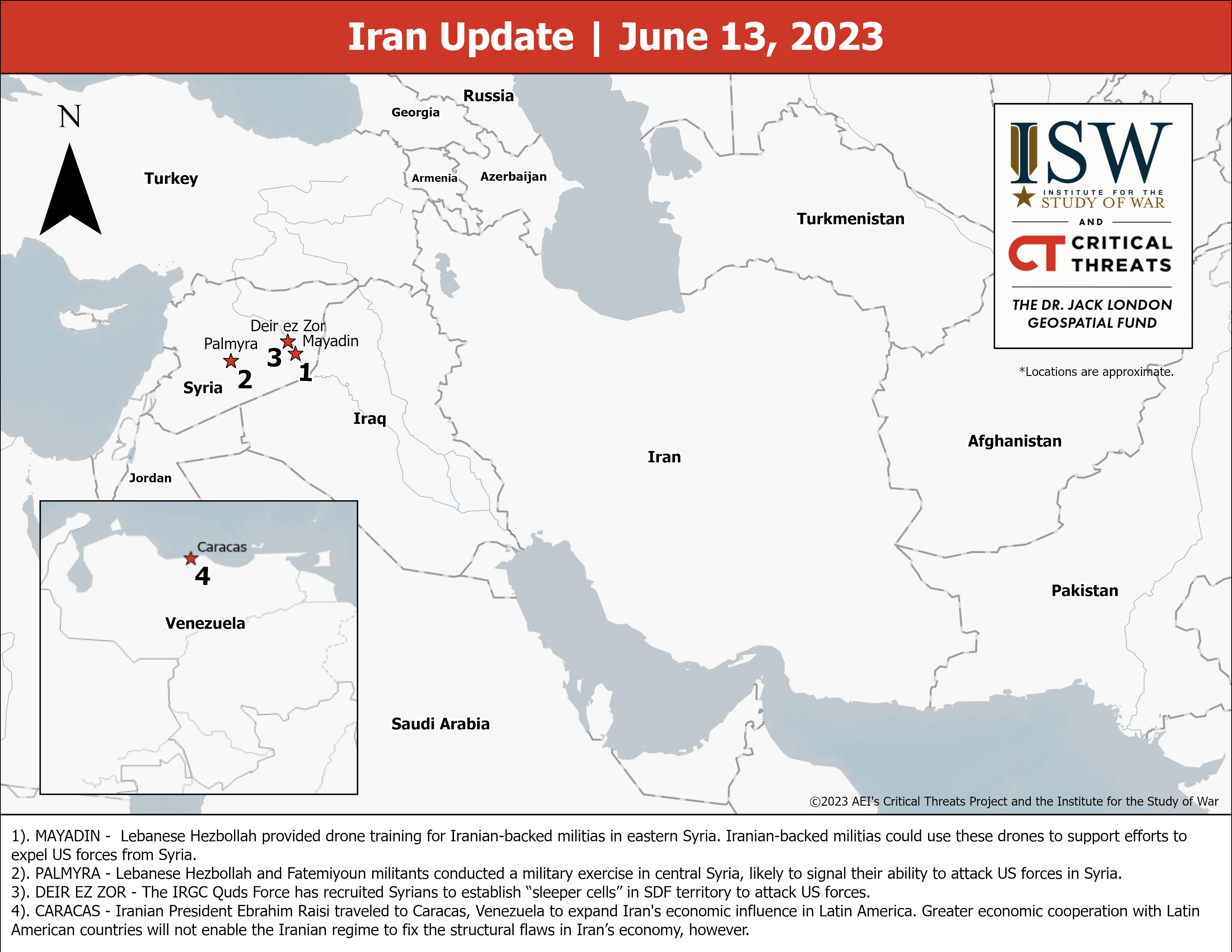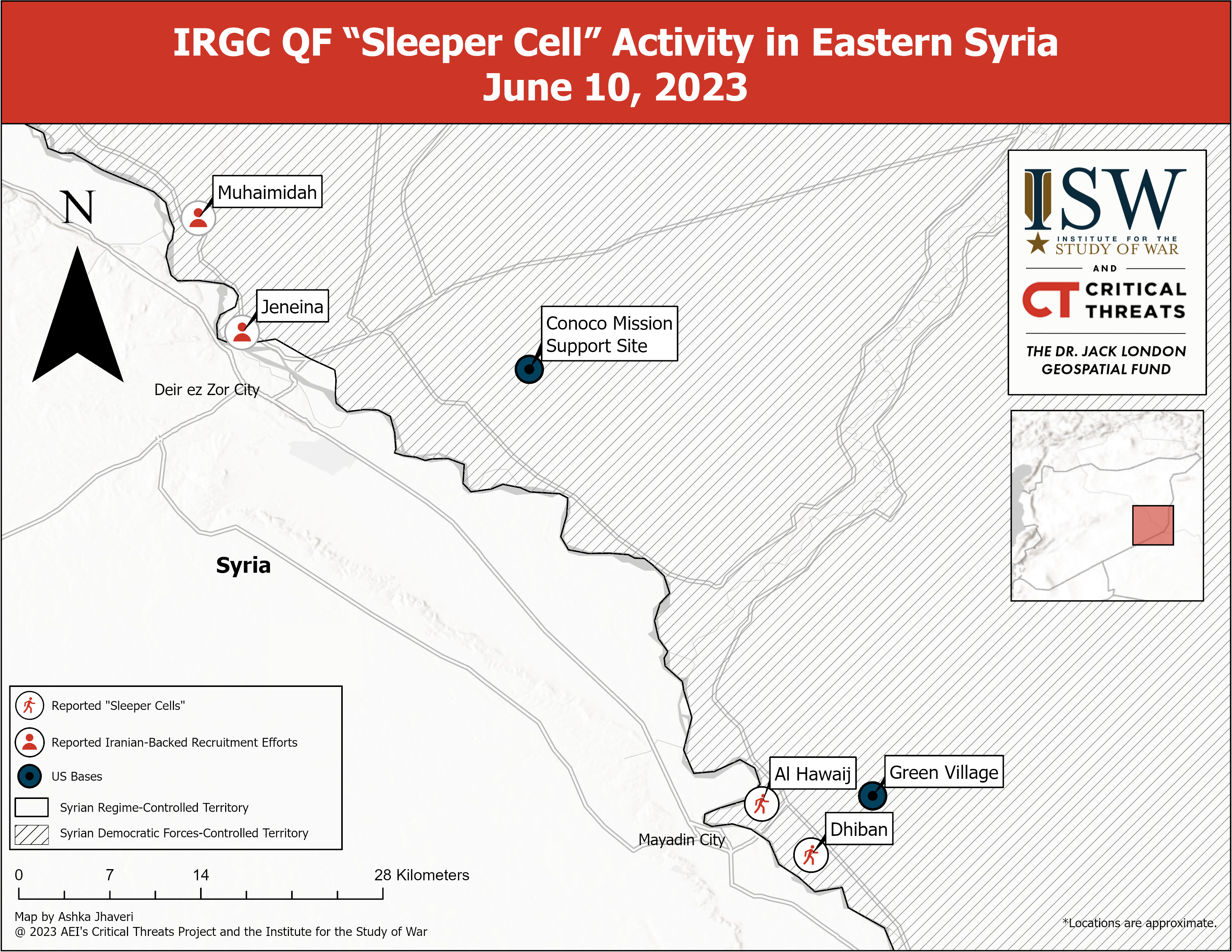Ashka Jhaveri, Annika Ganzeveld, and Nicholas Carl
The Iran Update aims to inform national security policy by providing timely, relevant, and independent open-source analysis of developments pertaining to Iran and its Axis of Resistance. This update covers political, military, and economic events and trends that affect the stability and decision-making of the Iranian regime. It also provides insights into Iranian and Iranian-sponsored activities abroad that undermine regional stability and threaten US forces and interests. The Critical Threats Project (CTP) at the American Enterprise Institute with support from the Institute for the Study of War (ISW) provides these updates Monday through Friday. To receive Iran Updates via email, please subscribe here.
The Institute for the Study of War (ISW) with support from the Critical Threats Project (CTP) at the American Enterprise Institute is launching a new interactive map of Iran and the Middle East. The map depicts events in Iran that affect the stability of the Iranian regime, namely anti-regime protests and reported poisoning incidents. It also shows developments in Syria that jeopardize regional stability and pose threats to US forces and interests, including Iranian and Iranian-backed militia positions.
Key Takeaways
- Lebanese Hezbollah provided drone training for Iranian-backed militias in eastern Syria. Iranian-backed militias could use these drones to support efforts to expel US forces from Syria.
- Lebanese Hezbollah and Fatemiyoun militants conducted a military exercise in central Syria, likely to signal their ability to attack US forces in Syria.
- The IRGC Quds Force has recruited Syrians to establish “sleeper cells” in Syrian Democratic Forces (SDF) territory to attack US forces.
- Iranian President Ebrahim Raisi traveled to Caracas, Venezuela to expand Iran's economic influence in Latin America. Greater economic cooperation with Latin American countries will not enable the Iranian regime to fix the structural flaws in Iran’s economy, however.
Iranian Activities in the Levant
This section covers Iranian efforts to consolidate and expand Tehran’s economic, military, and political influence throughout the Levant and especially in Syria. This section examines some of the many campaigns that Iran is pursuing to achieve this strategic objective. CTP will update and refine our assessments of these campaigns over time and in future updates.
CTP is monitoring Iranian and Iranian-backed militia efforts to arm, train, and recruit forces in Syria to renew their campaign against US forces there. The following developments are consistent with CTP’s observed indicators that Iran is setting conditions to attack.
Lebanese Hezbollah (LH) provided drone training for Iranian-backed militias in eastern Syria. Iranian leaders in Mayadin City brought the LH drone experts to begin training militias on the Iranian-made Qasef-1 and Ababil-3 drones on June 12.[1] The Qasef-1 has a range of 150 to 200 kilometers and can fly for two hours, enabling the militias to attack US forces deep inside Syrian Democratic Forces (SDF)-controlled territory.[2] The Iranian-backed militia Liwa al Ghaliboun used the Qasef-1 loitering munition in an attack from Iraq against US forces in Hasakah Province, Syria on March 23.[3] The Ababil-3 can carry surveillance or combat payloads and has a range of around 100 kilometers. The IRGC Quds Force previously delivered the drone to Iranian-backed militias in Syria.[4] LH training Iranian-backed militias in Syria to use the drones is part of a larger Iranian effort to develop the military capabilities of Iranian-backed forces in Deir ez Zor Province.[5]
Iranian-backed militias could use these drones to support efforts to expel US forces from Syria. Iranian-backed militias have previously conducted intelligence, surveillance, and reconnaissance drone flights over US positions and targeted US bases in Syria with attack drones.
LH and Fatemiyoun militants conducted a military exercise in central Syria on June 10, likely to signal their ability to attack US forces in Syria.[6] Around 100 militants participated in the exercise near Palmyra City and used Iranian-made rockets, drones, and artillery to simulate a battle. Anti-Syrian regime media Qasioun News reported Iranian-backed militants modified weapons at the Mahin warehouses in Homs Province and that high-ranking LH and IRGC officers oversaw the exercise.[7] LH previously brought officers specialized in modifying and developing weapons and missiles to the Mahin warehouses in July 2022.[8] The location of the mock battle and the rockets the militants used suggests Iran intended to demonstrate the threat of an attack on US forces in central Syria. The exercise took place roughly 60 kilometers from the US Al Tanf 55-kilometer exclusion zone. LH militants brought medium range Iranian-made rockets, which have an estimated range of 70 kilometers, to a warehouse southwest of Palmyra city on June 9.[9]
CTP is considering two hypotheses as to how Iranian-backed militants may have modified the rocket systems. First, Iranian-backed militants extended the range of the rockets to reach further into the exclusion zone. Iranian-made medium range rockets such as the Fajr-3 and Fajr-5, for example, have a maximum range of 70 kilometers, which fails to hit the US Al Tanf Garrison from the military training location.[10] Second, Iranian-backed militants modified the accuracy of rocket systems to more accurately target US forces in the exclusion zone.
The IRGC Quds Force has recruited Syrians to establish “sleeper cells” in SDF territory to attack US forces.[11] Local anti-Syrian regime media Deir Ezzor 24 reported on June 10 that the IRGC Quds Force tasked the cells with monitoring US positions, planting explosive devices, and spreading clan strife in the SDF region.[12] Iran has funded and armed tribal militias in SDF-territory precisely in preparation for taking SDF territory following US withdrawals.[13] The IRGC Quds Force is collaborating with the Syrian regime and local leaders, including an Iranian-backed sheikh, to form these cells.[14] The Syrian regime’s State Security branch is issuing security cards to enable the cells to transfer between SDF and Syrian regime territory.[15] This ongoing Iranian effort to establish attack cells in SDF-territory supports CTP’s assessment that Iran may be preparing to attack US forces.
Iranian Domestic Affairs
This section covers factors and trends affecting regime decision-making and stability. CTP will cover domestic politics, significant protest activity, and related issues here.
Iranian President Ebrahim Raisi traveled to Caracas, Venezuela on June 12 to expand Iran's economic influence in Latin America. Greater economic cooperation with Latin American countries will not enable the Iranian regime to fix the structural flaws in Iran’s economy, however. Raisi’s trip to Venezuela marks the first official visit of an Iranian president to this country since September 2016.[16] Raisi was accompanied by Iran’s ministers for culture, defense, foreign affairs, health, and oil. These ministers signed 19 agreements, covering cooperation in the fields of agriculture, energy, communications and information technology, maritime transport, and minerals, with their Venezuelan counterparts on June 13.[17] Iranian Oil Minister Javad Owji specified that the energy agreement promotes the joint development of oil terminals and loading docks.[18] Raisi separately stated during a press conference with Venezuelan President Nicolas Maduro on June 13 that Iran and Venezuela aim to increase bilateral trade to 20 billion dollars, which is over 500 times greater than Iran and Venezuela’s current trade volume.[19] Increased economic cooperation with Venezuela could provide some economic relief to Iran but will not resolve the Iranian economy’s structural problems. Greater bilateral trade with foreign countries would enable Iran to increase its capital inflows but will not solve the problems that underlie Iran’s economic instability. Fundamental economic reforms—such as reducing the dominance of para-statal organizations in Iran’s economy and combatting corruption and nepotism—would be necessary to meaningfully improve Iran’s economy.
Raisi’s visit to Venezuela is part of a broader trend of growing Iranian-Venezuelan cooperation since 2020. Raisi and Maduro previously signed a 20-year cooperation agreement, covering oil, petrochemical, defense, agricultural, and cultural cooperation, during Maduro’s June 2022 visit to Tehran.[20] The Iranian regime has additionally exported condensates and heavy crude oil to Venezuela, repaired Venezuelan refineries, and delivered oil tankers to Venezuela.[21] Iran has, in return, established several car and tractor manufacturing factories in Venezuela, used Venezuelan land for agricultural production, and imported Venezuelan heavy oil and gold.[22]
[1] https://deirezzor24 (dot) net/en/the-iranian-revolutionary-guard-militia-receives-warplanes-experts-to-deir-ezzor/
[3] https://www.defense.gov/News/Releases/Release/Article/3339691/us-conduct... https://twitter.com/VivaRevolt/status/1639277611808432128
[4] https://www.criticalthreats.org/analysis/irans-drone-inventory-and-poten... https://thiqa-agency (dot) com/%d8%aa%d8%b6%d9%85-%d8%b7%d8%a7%d8%a6%d8%b1%d8%a7%d8%aa-%d9%85%d8%b3%d9%8a%d8%b1%d8%a9-%d9%88%d8%b5%d9%88%d9%84-%d8%b4%d8%ad%d9%86%d8%a9-%d8%a3%d8%b3%d9%84%d8%ad%d8%a9-%d8%a5%d9%8a%d8%b1%d8%a7/
[5] https://deirezzor24 (dot) net/en/the-iranian-revolutionary-guard-militia-receives-warplanes-experts-to-deir-ezzor/; https://eyeofeuphrates (dot) com/ar/news/2023/05/22/8591; https://eyeofeuphrates (dot) com/ar/news/2023/05/09/8457; https://furat-sy.com/2022/10/23/11911/
[6] https://halabtodaytv (dot) net/archives/250806; https://qasioun-news (dot) com/ar/articles/263448
[7] https://qasioun-news (dot) com/ar/articles/263448
[8] https://nedaa-post (dot) com/%d8%a8%d9%87%d8%af%d9%81-%d8%aa%d8%b7%d9%88%d9%8a%d8%b1-%d8%a7%d9%84%d8%a3%d8%b3%d9%84%d8%ad%d8%a9-%d8%ad%d8%b2%d8%a8-%d8%a7%d9%84%d9%84%d9%87-%d9%8a%d8%b1%d8%b3%d9%84-%d9%85%d8%ae%d8%aa%d8%b5%d9%8a%d9%86-%d9%84%d9%85%d8%b3%d8%aa%d9%88%d8%af%d8%b9%d8%a7%d8%aa-%d9%85%d9%87%d9%8a%d9%86-%d8%b4%d8%b1%d9%82-%d8%ad%d9%85%d8%b5/
[9] https://missilethreat.csis.org/country/hezbollahs-rocket-arsenal/; https://qasioun-news (dot) com/ar/articles/263490
[11] https://deirezzor24 (dot) net/en/the-iranian-revolutionary-guard-militia-is-planting-and-operating-cells-in-sdf-held-areas/
[12] https://deirezzor24 (dot) net/en/the-iranian-revolutionary-guard-militia-is-planting-and-operating-cells-in-sdf-held-areas/
[14] https://deirezzor24 (dot) net/en/the-iranian-revolutionary-guard-militia-is-planting-and-operating-cells-in-sdf-held-areas/
[15] https://deirezzor24 (dot) net/en/the-iranian-revolutionary-guard-militia-is-planting-and-operating-cells-in-sdf-held-areas/
[16] https://president dot ir/fa/144633 ;
https://www.middleeastmonitor dot com/20230609-iran-president-to-visit-3-us-sanctioned-latin-american-countries-to-bolster-ties/
[17] https://president dot ir/fa/144665 ;
https://www.tasnimnews dot com/fa/news/1402/03/23/2910458
[18] https://www.tasnimnews dot com/fa/news/1402/03/23/2910458
[19] https://president dot ir/fa/144672
[21] https://www.eia.gov/international/content/analysis/countries_long/Iran/p... ;
https://www.reuters.com/business/energy/iranian-oil-tanker-arrives-venez... ;
https://www.jpost dot com/international/article-730544


